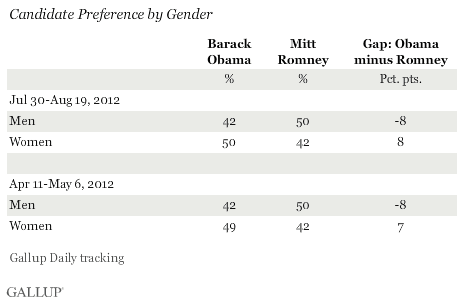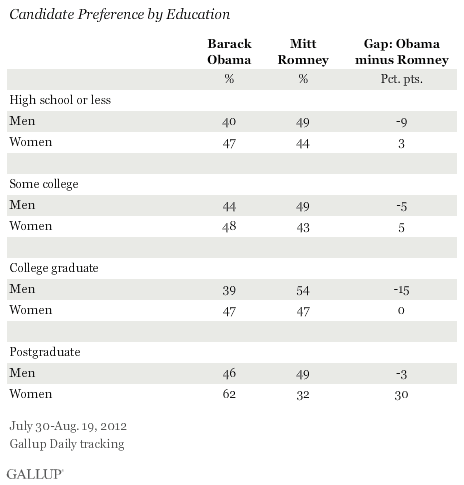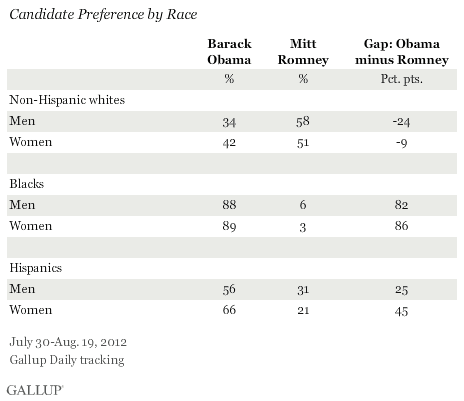PRINCETON, NJ -- Male voters currently prefer Mitt Romney over Barack Obama by an eight-percentage-point margin, while female voters prefer Obama over Romney by an identical eight points. These gender-gap figures, based on Gallup Daily tracking conducted July 30-Aug. 19, are virtually identical to what they were four months ago.

The impact of gender on the presidential race has received a renewed focus in recent days after Missouri Republican senatorial candidate Todd Akin's controversial comments about rape and abortion. It's too early to tell if this incident and the resulting fallout will have a long-term impact on the presidential gender gap, but from a broad perspective, Gallup's large sample sizes show a remarkable stability by gender since tracking began in mid-April.
The gender gap is driven mostly by the underlying differences in party identification. Women are more likely to identify as Democrats and less likely to identify as independents than are men. Within party groups, gender gaps are quite small.

Gender Gap Most Evident Among Youngest and Oldest Voter Groups
The gender gap is evident across all age groups. Both men and women younger than 30 prefer Obama, but the margin is significantly greater among young women. Similarly, men and women 65 and older prefer Romney, but the gap is 23 points among older men, compared with five points among older women.

Postgraduates Most Split by Gender
Gender makes a difference at each level of education -- but particularly so among voters with postgraduate education.
Women either prefer Obama over Romney or give each equal support, regardless of their educational attainment. Men, on the other hand, support Romney across each educational group, although support is slim among men with postgraduate education.

The gender gap among voters with postgraduate education is remarkable, with a three-point margin for Romney among men in this group, compared with a 30-point Obama lead among women.
Gender Gap Almost Disappears Among Blacks
There is little gender gap among black voters, with almost nine in 10 black men and black women indicating a preference for Obama over Romney.

On the other hand, the gender gap is significant among whites and Hispanics. White men prefer Romney over Obama by a 24-point margin, compared with a nine-point margin among white women. Hispanic men and Hispanic women tilt strongly toward Obama, but Hispanic men less so, by 25 points vs. 45 points, respectively.
Bottom Line
The gender gap in presidential preferences has not changed over the last four months, with men preferring Romney over Obama by eight points, while women prefer Obama by an identical margin.
The nature of the gender gap varies significantly across demographic segments. Support for Obama is so strong among black voters that gender makes little difference, but both white and Hispanic women are more likely to support Obama than are men in each of these groups. Women are more strongly for Obama than are men across all age groups, and the gender gap is starkly evident among voters with postgraduate education.
All in all, Obama's strongest support among women comes among those who are under 30, those with postgraduate education, and those who are black and Hispanic. Conversely, Romney receives his strongest support among men who have college degrees but no postgraduate education, and among older and white men.
Survey Methods
Results for this USA Today/Gallup poll are based on telephone interviews conducted July 30-Aug. 19, 2012, with a random sample of 9,678 registered voters, aged 18 and older, living in all 50 U.S. states and the District of Columbia.
For results based on the total sample of voters, one can say with 95% confidence that the maximum margin of sampling error is ±1 percentage point.
Interviews are conducted with respondents on landline telephones and cellular phones, with interviews conducted in Spanish for respondents who are primarily Spanish-speaking. Each sample includes a minimum quota of 400 cell phone respondents and 600 landline respondents per 1,000 national adults, with additional minimum quotas among landline respondents by region. Landline telephone numbers are chosen at random among listed telephone numbers. Cell phone numbers are selected using random-digit-dial methods. Landline respondents are chosen at random within each household on the basis of which member had the most recent birthday.
Samples are weighted by gender, age, race, Hispanic ethnicity, education, region, adults in the household, and phone status (cell phone only/landline only/both, cell phone mostly, and having an unlisted landline number). Demographic weighting targets are based on the March 2011 Current Population Survey figures for the aged 18 and older non-institutionalized population living in U.S. telephone households. All reported margins of sampling error include the computed design effects for weighting and sample design.
In addition to sampling error, question wording and practical difficulties in conducting surveys can introduce error or bias into the findings of public opinion polls.
For more details on Gallup's polling methodology, visit www.gallup.com.
